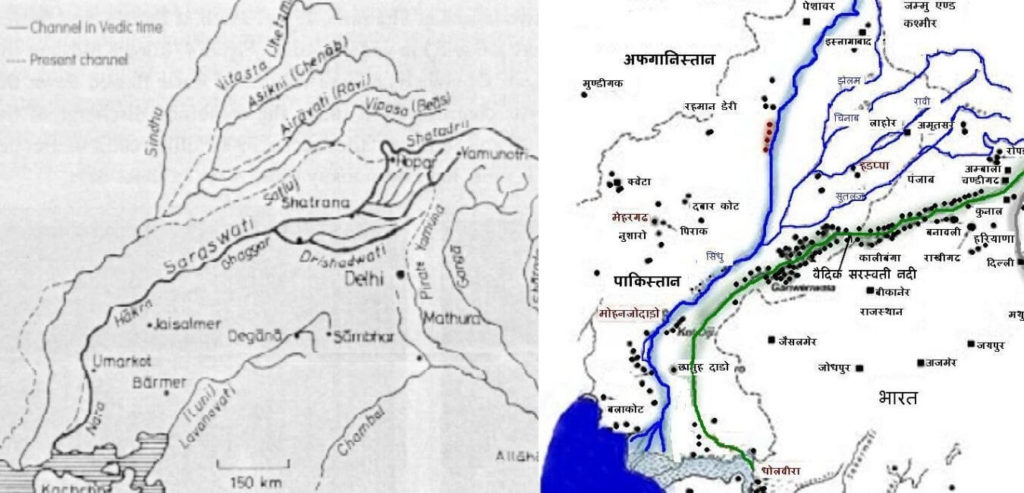The Rigveda mentions Sapta Sindhu – the seven rivers of NW India , traced from east to west as Sarasvati, Satadru ( Sutlej ), Vipasa (Beas), Parosni (Ravi) , Asikni (Chenab) Vitasta (Jhelum) and Sindhu (Indus). Latyayana Srautasutra has described drishadvati as a seasonal river, while Saraswati as a perennial river up to Vinasana. In the Manu Smriti, Drishadvati river and the Sarasvati River define the boundaries of the Vedic state of Brahmavarta. Both Sarasvati & Drishadvati are believed to have been flowing through the region of Rajasthan but with time both these rivers have disappeared completely. This page attempts to revisit these Lost Rivers of Rajasthan.
Source of Information:
Information on Prehistoric India comes from two distinct sources:
- The literary tradition represented in the main by the faithfully preserved corpus of Vedic texts headed by the Rigveda.
- The archaeological tradition ranging from the Aceramic Neolithic of Mehrgarh and the various phases of the Harappan civilization to the Iron Age Painted Grey Ware and the Northern Black Polished Ware cultures.
3. In recent times, a third-dimension or third perspective has been added in form of Scientific Research through use of modern Technology, where Remote sensing data from satellites and aerial cameras is used to map the palaeo-channels. This aided by additional techniques like drilling at selective locations radiocarbon age analysis of the water samples thus obtained to confirm presence of palaeo-channels.
1. Lost Rivers of Rajasthan: References in Ancient Indian Texts
Sarasvati River:
Ambitame, naditame, devitame, Sarasvati
Aprasasta iva smasi prasastim Amba naskriti. — (Rigveda – 2. 41. 16)
(O Sarasvati, you the best of mothers, the best of rivers, the best of gods ! Although we are of no repute, mother, grant us distinction.)
- During the vedic civilization, Aryans developed Rigveda, which describes about the ” Sapta Sindhu ” the seven rivers of NW India , traced from east to west as Sarasvati, Satadru ( Sutlej ), Vipasa (Beas), Parosni (Ravi) , Asikni (Chenab) Vitasta (Jhelum) and Sindhu (Indus) which started flowing consequent on the melting of the Himalayan glaciers at the end of Pleistocene.
- According to the Mahabharata, the Sarasvati dried up in a desert (at a place named Vinasana or Adarsana).
- In the Skanda Purana, the Sarasvati originates from the water pot of Brahma and flows from Plaksa on the Himalayas. It then turns west at Kedara and also flows underground. Five distributaries of the Sarasvati are mentioned.
- In the Manu Smriti, the sage Manu, escaping from a flood, founded the Vedic culture between the Sarasvati and Drishadvati rivers. The Sarasvati River was thus the western boundary of Brahmavarta.
Drishadvati River:
The Drishadvati river is hypothesized by Indologists to identify the route of vedic river, Saraswati, and the state of Brahmavarta. Brahmavarta is postulated as a state during vedic times, situated on the confluence of the revered rivers Saraswati and Drishadwati. Different literary sources that mention Drishadvati include:
- Latyayana Srautasutra has described drishadvati as a seasonal river, while Saraswati as a perennial river up to Vinasana.
- Brahmanas often mention the Drishadwati River. Brahmanas point out that Drishadwati River had its origin from the pot of Brahma i.e. Pushkar lake, near Ajmer. Pushkar has the most revered Brahma temple in India.
- In the Manu Smriti, Drishadvati river and the Sarasvati River define the boundaries of the Vedic state of Brahmavarta.
- According to Srimad Bhagavatam, the Drsadvati is one of the many transcendental rivers in India.
2. The Lost Rivers of Rajasthan: As per Archaeological Findings
Sarasvati River:
- More than 1200 ancient settlements on Sarasvati river basin have been dug out giving clinching evidence of existence of a mighty river, which sustained maritime civilization and metal-based economy prior to 3000 BC.
- Archaeological Survey of India has dug out more than 2400 settlements at the ancient Indus-Sarasvati river basins but no ancient settlements have been found along the present day course of Yamuna or Sutlej.
- Land was fertile and barley etc were cultivated in the Sarasvati region even 7000 years back and same style of cultivating the fields continues till date in areas like Rajasthan & Haryana.
Drishadvati:
The first serious attempt on Drishadvati river was made by Sir Alexander Cunningham (1871) who identified the Drishadvati with the present Rakhsi river while Rapson (1914) felt that the Drishadvati used to flow through the present course of Chautang river which originates in Siwaliks.
Subsquently, Keith (1922) and Dey (1927) also supported the course of the Drishadvati as being the present Chautang river and then along the Hansi —Hissar branch of the western Yamuna canal.
The Lost Rivers of Rajasthan: Scientific Research
Saravati River
Since the late 19th-century, scholars have postulated that the Ghaggar-Hakra River system is the remnant of Vedic Saraswati river.
In 2016, K. S Valdiya committee constituted by Government of India on Palaeochannels of North-West India: Review and Assessment, concluded that Saraswati river had two branches eastern & western. The eastern branch included Sarsuti-Markanda rivulets in Haryana and the western branches included Ghaggar-Patiali channels. The committee considers that branches met near Patiala, at Shatrana, then flowed as a large river.
Contradictions:
However, in recent times, these views have been contradicted by geophysical research, which suggests that the Ghaggar-Hakra system, although having greater discharge in Harappan times which was enough to sustain human habitation, was not watered by a Himalayan river—such as the Sarasvati—but rather by a system of perennial, but only monsoon fed, rivers.
Other research using dating of zircon sand grains has shown that late Pleistocene subsurface river channels near the present-day Indus Valley Civilisation sites in the Cholistan desert, in Pakistan, immediately below the dry Ghaggar-Hakra bed show sediment affinity with not with the Ghagger-Hakra river, but with the Beas river in the western sites and the Sutlej and Yamuna rivers in the eastern ones.

